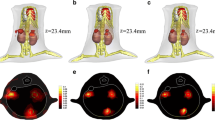Abstract
Purpose
Bioluminescence tomography (BLT) is a promising in vivo optical imaging technique in preclinical research at cellular and molecular levels. The problem of BLT reconstruction is quite ill-posed and ill-conditioned. In order to achieve high accuracy and efficiency for its inverse reconstruction, we proposed a novel approach based on L p regularization with the Split Bregman method.
Procedures
The diffusion equation was used as the forward model. Then, we defined the objective function of L p regularization and developed a Split Bregman iteration algorithm to optimize this function. After that, we conducted numerical simulations and in vivo experiments to evaluate the accuracy and efficiency of the proposed method.
Results
The results of the simulations indicated that compared with the conjugate gradient and iterative shrinkage methods, the proposed method is more accurate and faster for multisource reconstructions. Furthermore, in vivo imaging suggested that it could clearly distinguish the viable and apoptotic tumor regions.
Conclusions
The Split Bregman iteration method is able to minimize the L p regularization problem and achieve fast and accurate reconstruction in BLT.




Similar content being viewed by others
References
Ntziachristos V, Ripoll J, Wang LHV, Weissleder R (2005) Looking and listening to light: the evolution of whole-body photonic imaging. Nat Biotechnol 23:313–320
Weissleder R, Pittet MJ (2008) Imaging in the era of molecular oncology. Nature 452:580–589
Wang K, Chi CW, Hu ZH et al (2015) Optical molecular imaging frontiers in oncology: the pursuit of accuracy and sensitivity. Engineering 1:309–323
Hu ZH, Qu YW, Wang K et al (2015) In vivo nanoparticle-mediated radiopharmaceutical-excited fluorescence molecular imaging. Nat Commun 6:7560
Wang G, Cong WX, Durairaj K et al (2006) In vivo mouse studies with bioluminescence tomography. Opt Express 14:7801–7809
Willmann JK, van Bruggen N, Dinkelborg LM, Gambhir SS (2008) Molecular imaging in drug development. Nat Rev Drug Discov 7:591–607
Wang G, Li Y, Jiang M (2004) Uniqueness theorems in bioluminescence tomography. Med Phys 31:2289–2299
Cong WX, Wang G, Kumar D et al (2005) Practical reconstruction method for bioluminescence tomography. Opt Express 13:6756–6771
Tikhonov AN (1977) Solutions of ill-posed problems. Scripta Series. In: Mathematics Isbn 0-470-99124-0 Vh Winston & Sons, Publishers, 1511 K Street, Nw, Washington 20005 Xiii + 258 P 221 Ref Index An English-language Translation Of Metody Resheniia Nekor Rektnykh Zadach, Published By Nauka In
Donoho DL (2006) Compressed sensing. IEEE T Inform Theory 52:1289–1306
Yi HJ, Chen DF, Li W, et al. (2013) Reconstruction algorithms based on l(1)-norm and l(2)-norm for two imaging models of fluorescence molecular tomography: a comparative study. J Biomed Opt 18:056013
Yu JJ, Liu F, Wu JA et al (2010) Fast source reconstruction for bioluminescence tomography based on sparse regularization. IEEE Trans Biomed Eng 57:2583–2586
Lv YJ, Tian J, Cong WX et al (2006) A multilevel adaptive finite element algorithm for bioluminescence tomography. Opt Express 14:8211–8223
Shi JW, Liu F, Zhang GL, et al. (2014) Enhanced spatial resolution in fluorescence molecular tomography using restarted L1-regularized nonlinear conjugate gradient algorithm. J Biomed Opt 19:046018
Guo W, Jia KB, Zhang Q et al (2012) Sparse reconstruction for bioluminescence tomography based on the semigreedy method. Comput Math Method M 2012:494808
Feng JC, Qin CH, Jia KB et al (2012) Total variation regularization for bioluminescence tomography with the split Bregman method. Appl Optics 51:4501–4512
Leng CC, Tian J (2015) Mathematical method in optical molecular imaging. Sci China Inform Sci 58:031101 (13)
Gu XJ, Zhang QH, Larcom L, Jiang HB (2004) Three-dimensional bioluminescence tomography with model-based reconstruction. Opt Express 12:3996–4000
Leng CC, Yu DD, Zhang S et al (2015) Reconstruction method for optical tomography based on the linearized Bregman iteration with sparse regularization. Comput Math Method M 2015:304191
Prahl SA, Vangemert MJC, Welch AJ (1993) Determining the optical-properties of turbid media by using the adding-doubling method. Appl Optics 32:559–568
Yan GR, Tian J, Zhu SP et al (2008) Fast cone-beam CT image reconstruction using GPU hardware. J X-Ray Sci Technol 16:225–234
Zhu S, Tian J, Yan G et al (2009) Cone beam micro-CT system for small animal imaging and performance evaluation. Int J Biomed Imaging 2009:960573
Wu P, Hu YF, Wang K, Tian J (2014) Bioluminescence tomography by an iterative reweighted l(2)-norm optimization. IEEE Trans Biomed Eng 61:189–196
Goldstein T, Osher S (2009) The Split Bregman method for L1-regularized problems. Siam J Imaging Sci 2:323–343
Acknowledgments
This work is supported by the National Natural Science Foundation of China under Grant Nos. 81571836,30970777,81227901, 61231004, 81527805, and 61401462; the National Basic Research Program of China (973 Program) under Grant No. 2015CB755500; the Scientific Research and Equipment Development Project of the Chinese Academy of Sciences under Grant No. YZ201359; the Key Research Program of the Chinese Academy of Sciences under Grant No. KGZD-EW-T03; and the Open Research Project under Grant 20150103 from SKLMCCS.
Author information
Authors and Affiliations
Corresponding authors
Ethics declarations
Conflict of Interest
The authors declare that they have no conflict of interest.
Rights and permissions
About this article
Cite this article
Hu, Y., Liu, J., Leng, C. et al. L p Regularization for Bioluminescence Tomography Based on the Split Bregman Method. Mol Imaging Biol 18, 830–837 (2016). https://doi.org/10.1007/s11307-016-0970-9
Published:
Issue Date:
DOI: https://doi.org/10.1007/s11307-016-0970-9




